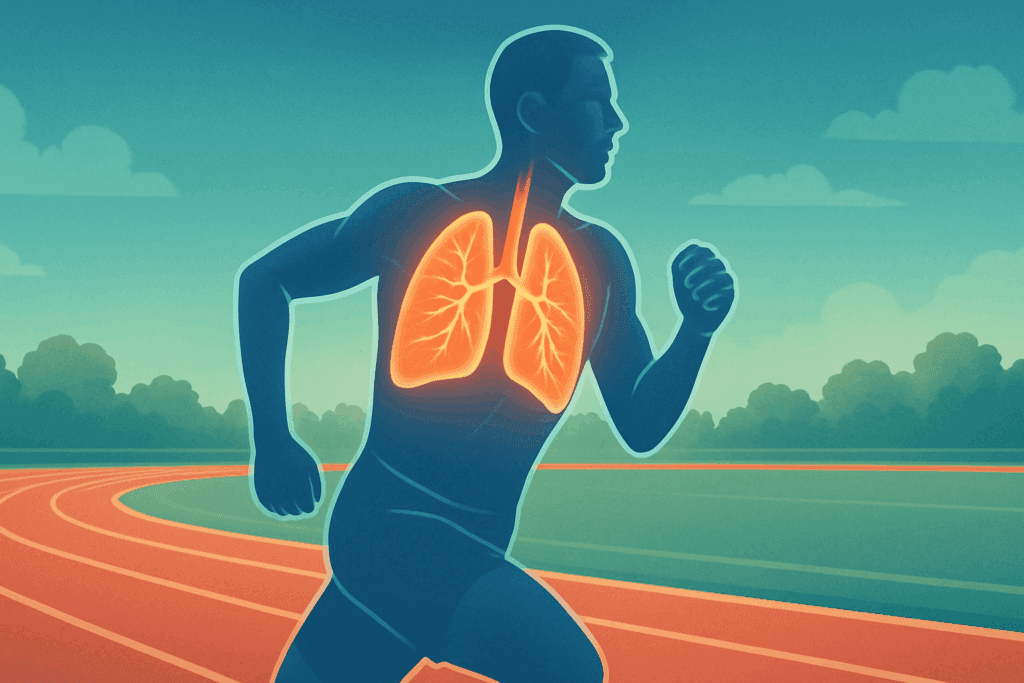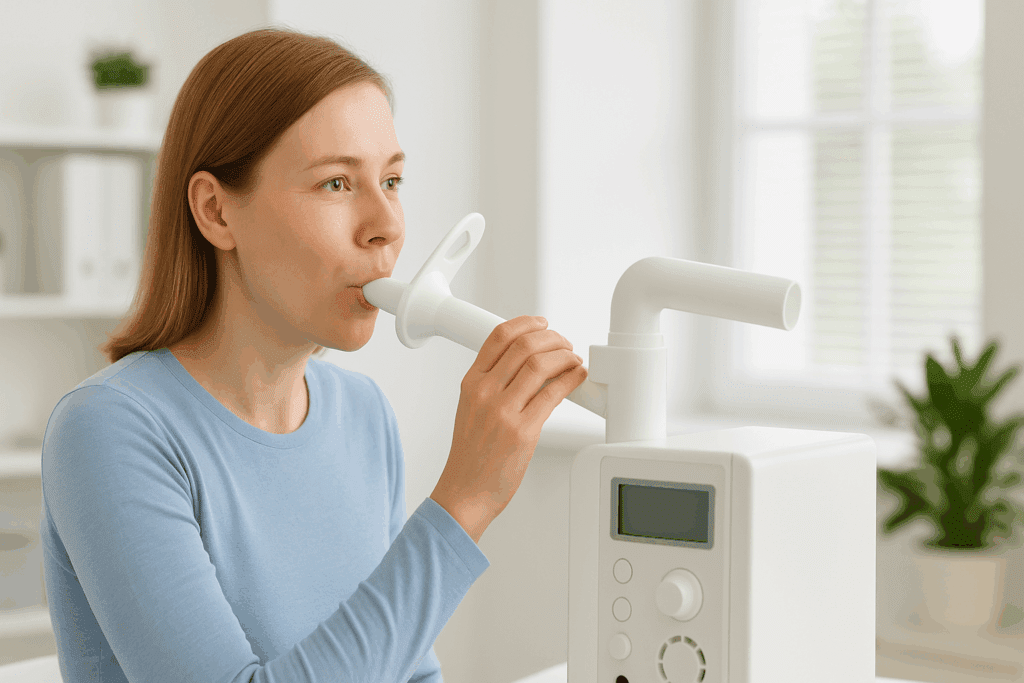Lung health plays a vital role in how we perform physically and mentally, yet it’s often neglected until issues arise. The lungs supply oxygen to our body, fueling every cell and supporting metabolic processes that keep us alive and thriving. Whether you’re an athlete seeking peak performance, someone recovering from illness, or simply interested in enhancing overall wellness, learning how to improve lung capacity can be transformative. This article explores how to increase lung capacity, how to improve lung function, and how to work on lung power using scientifically supported, targeted breathing techniques. With consistency, intention, and informed practice, you can unlock your respiratory potential naturally.
You may also like: How to Increase Stamina and Endurance Naturally: Smart Training Tips and Nutrition Habits That Support Cardiovascular Fitness

Understanding Lung Capacity and Its Impact on Performance
Lung capacity refers to the total amount of air your lungs can hold, and it directly influences how efficiently oxygen is delivered to the bloodstream and distributed throughout the body. Athletes with greater lung capacity often experience enhanced stamina, quicker recovery times, and improved endurance, which can provide a competitive edge in performance-driven settings. But you don’t need to be a professional athlete to benefit—anyone can experience profound gains in energy and vitality by learning how to increase breathing capacity through structured lung workouts.
The decline in lung function often starts subtly, influenced by factors like sedentary lifestyle, environmental pollutants, smoking, or chronic respiratory conditions. While genetics can play a role, lifestyle modifications and intentional pulmonary exercises are often powerful enough to counteract these influences. When you understand how to gain lung capacity and apply that knowledge consistently, your physical output, mental clarity, and immune resilience can all improve.
How to Increase Lung Capacity Through Functional Breathing Techniques
One of the most accessible ways to begin enhancing your respiratory efficiency is through functional breathing techniques. These exercises help regulate the depth, rhythm, and efficiency of breath, creating more space for oxygen exchange and training the diaphragm to work more effectively. Diaphragmatic breathing, also known as belly breathing, is often regarded as the best exercise to improve lung function for beginners. It involves consciously engaging the diaphragm rather than shallow chest breathing, which promotes deeper lung expansion and better oxygen delivery.
If you’re wondering how to make your lungs stronger without the need for equipment or intense physical strain, start by lying flat on your back with one hand on your chest and one on your abdomen. As you inhale through the nose, focus on expanding the belly rather than the chest. Exhale slowly through the mouth. Repeating this for ten minutes daily can dramatically impact your lung function over time. For individuals managing chronic conditions such as COPD, breathing techniques for COPD should be done under medical guidance, but diaphragmatic breathing remains a foundational method recommended by respiratory therapists worldwide.

The Science of Pulmonary Exercises and Their Benefits
Pulmonary exercises are structured practices designed to improve lung strength, oxygen exchange, and airway clearance. These routines often incorporate breath holds, inspiratory resistance training, and controlled exhalation techniques. Regular practice helps reduce breathlessness, improve oxygen saturation levels, and increase respiratory muscle endurance. These benefits are especially critical for people managing respiratory illnesses like pneumonia, asthma, or chronic obstructive pulmonary disease.
Breathing exercises for pneumonia recovery, for example, can aid in clearing mucus and improving ventilation in previously collapsed areas of the lung. For those seeking how to enhance lung capacity after illness, consistent pulmonary training not only accelerates recovery but also builds long-term resilience against future infections. In athletic contexts, these exercises offer similar benefits by increasing oxygen uptake and carbon dioxide tolerance—two factors that contribute significantly to peak aerobic output.
How Often Should You Do Breathing Exercises with Bronchitis or COPD?
When navigating respiratory conditions like bronchitis or COPD, consistency and moderation are key. Understanding how often you should do breathing exercises with bronchitis depends on the severity of symptoms and current lung function. During acute phases, shorter, gentle sessions two to three times a day can help reduce inflammation and improve airflow. As symptoms stabilize, sessions may be extended and intensified.
For chronic conditions, daily breathing exercises to strengthen lungs are generally safe and highly encouraged, provided they are tailored to individual needs. Respiratory therapists frequently recommend breathing exercises for COPD patients to be performed at least once or twice daily, focusing on techniques like pursed-lip breathing and paced respiration. These methods help manage shortness of breath, reduce air trapping, and enhance oxygen efficiency. Over time, they also help boost lung capacity and increase functional lung volume.

Training the Respiratory Muscles: How to Work on Lung Power
Just like any other muscle group, the respiratory muscles—especially the diaphragm and intercostal muscles—can be trained for greater strength and endurance. Learning how to work on lung power involves resistance training for these muscles, often with devices like incentive spirometers or inspiratory muscle trainers. These tools add resistance to inhalation, prompting the muscles to work harder and adapt over time.
However, even without specialized equipment, lung workouts can include techniques like box breathing, breath holds, and high-repetition diaphragmatic breathing. These approaches challenge the muscles responsible for breathing, improving overall ventilation efficiency. For runners, knowing how to increase lung capacity for running can be a game-changer. Incorporating these methods into warm-up or cool-down routines can not only improve stamina but also reduce the perceived effort during high-intensity activity.
The Role of Breathing Exercises in Chronic Respiratory Conditions
Understanding how to improve lung function becomes especially critical in the context of chronic conditions like COPD, asthma, or bronchiectasis. For these individuals, breathing exercises for chronic obstructive pulmonary disease are more than just performance enhancers—they’re essential components of disease management. Techniques such as pursed-lip breathing help prolong exhalation, prevent airway collapse, and reduce the sensation of breathlessness.
What are the best breathing exercises for COPD? Research and clinical practice point to a combination of diaphragmatic breathing, pursed-lip breathing, and coordinated breathing during exertion. These methods improve alveolar ventilation, reduce hyperinflation, and support more effective gas exchange. Knowing how to improve lung function test results becomes more achievable with consistent practice of these clinically validated techniques, alongside medications and other physician-directed therapies.

Breathing Exercises to Prevent Pneumonia and Support Elderly Lung Health
Older adults often experience a gradual decline in lung elasticity and respiratory muscle tone. As such, breathing exercises for elderly individuals to improve lung function can significantly enhance quality of life, physical independence, and resistance to respiratory infections. Simple practices like seated diaphragmatic breathing or gentle breath-holding exercises can help maintain lung volume, reduce mucus buildup, and support robust immune function.
For pneumonia prevention—particularly among post-surgical or immobilized patients—breathing exercises to prevent pneumonia play a pivotal role. Techniques like incentive spirometry and sustained maximal inhalation exercises encourage deep breathing that ventilates the lower lobes of the lungs, where pneumonia often begins. Understanding how can you improve lung capacity through these interventions is vital in both clinical settings and at-home care scenarios.
How to Gain Lung Capacity with Endurance Training and Cardiorespiratory Fitness
Aerobic exercise, when paired with targeted breathing practices, offers a dual pathway for those looking to boost lung capacity. Activities like swimming, cycling, rowing, and running naturally demand deep, rhythmic breathing, which can increase tidal volume and promote lung elasticity. However, to fully reap these benefits, it’s essential to practice conscious breath control during these activities.
Those seeking how do you increase lung capacity for running, for example, can begin by integrating breath pacing strategies. Matching breathing patterns to stride count (e.g., inhale for three steps, exhale for two) can create rhythm, reduce fatigue, and build respiratory endurance. Over time, this approach increases aerobic threshold, allowing for longer exertion with less perceived effort. Athletes and casual exercisers alike can benefit from this holistic approach to respiratory fitness.

Targeted Lung Workouts for Enhanced Performance and Recovery
A lung workout isn’t confined to breath control alone. It can also include exercises that integrate physical movement and resistance-based breathing to simultaneously train the lungs and cardiovascular system. Practices like high-intensity interval training (HIIT) or breath-focused yoga routines challenge the respiratory muscles, increase oxygen utilization, and promote lung expansion.
For those wondering how can I strengthen my lungs in everyday routines, combining breath holds with physical movements like squats, walking lunges, or isometric holds can elevate both endurance and lung capacity. These compound challenges mirror the oxygen demands of real-world activity, making them especially useful for performance enhancement. Breathing for airways in this context supports not only aerobic function but also the clearance of residual air and metabolic waste from the lungs.
Diaphragmatic Breathing for COPD and Its Therapeutic Impact
Diaphragmatic breathing for COPD offers a safe, non-invasive way to improve respiratory efficiency, reduce dyspnea, and enhance quality of life. When practiced regularly, this technique retrains the body to rely more heavily on the diaphragm rather than accessory muscles of the neck and shoulders. This shift leads to more relaxed, energy-efficient breathing and less respiratory fatigue.
Incorporating diaphragmatic breathing COPD techniques into daily life is simple but powerful. Sitting upright, placing a hand on the abdomen, and consciously expanding the belly with each inhale allows individuals to monitor their breath and engage the diaphragm more fully. With time, this becomes second nature, significantly improving functional capacity and helping individuals rediscover their physical potential even in the face of chronic illness.
How to Improve Lung Function Test Results Naturally and Effectively
Pulmonary function tests (PFTs) are clinical assessments that measure how well the lungs take in and release air. If you’re exploring how to improve lung function test outcomes without medications, breathing exercises and aerobic training are your strongest allies. Techniques that increase forced vital capacity (FVC) and forced expiratory volume (FEV1) typically include inspiratory training, maximal exhalation drills, and long-duration breath holds.
Alongside structured exercise, lifestyle interventions like reducing environmental exposures (e.g., allergens or pollutants), staying hydrated, and practicing good posture can significantly impact lung mechanics. Understanding how can you improve lung function from a whole-body perspective ensures that every breath you take contributes to your health, longevity, and athletic performance.
Frequently Asked Questions (FAQ): Boosting Lung Capacity and Lung Function Naturally
1. Can singing or playing wind instruments help improve lung capacity? Yes, singing and playing wind instruments can significantly enhance lung function and endurance. These activities train the respiratory muscles and promote better breath control, which supports how to improve lung capacity over time. Through controlled exhalation and sustained vocal or instrumental tones, participants build strength in the diaphragm and intercostal muscles. These practices also increase awareness of breathing patterns, which is crucial for those aiming to learn how to gain lung capacity efficiently. As a form of artistic expression, they also reduce stress, which further enhances respiratory efficiency by lowering tension in the upper chest and shoulders.
2. How does posture influence the ability to increase lung function? Poor posture—especially slouching—restricts the full expansion of the lungs by compressing the diaphragm and crowding the chest cavity. Learning how to increase lung capacity effectively includes adopting upright, open postures that allow the lungs to fill fully with air. Simple adjustments like aligning the spine and opening the chest can dramatically influence how to work on lung power throughout the day. Incorporating posture-focused movement practices like yoga or tai chi can further support pulmonary alignment and breathing for airways, especially for individuals with chronic respiratory conditions. A conscious shift in posture during sitting, walking, or exercising promotes deeper, more oxygen-rich breaths.
3. Are there psychological benefits tied to breathing exercises that strengthen lungs? Absolutely. In addition to physiological improvements, regular breathing exercises to strengthen lungs also promote psychological well-being. These techniques can regulate the autonomic nervous system, reducing symptoms of anxiety and promoting relaxation. Many individuals report enhanced emotional resilience when they practice breathing exercises for chronic obstructive pulmonary disease or during recovery periods. This interplay between breath and emotional regulation also supports how to enhance lung capacity because calm, consistent breathing patterns help avoid shallow, stress-induced respiration. Over time, mental clarity and focus may improve, enhancing overall quality of life.
4. What is the relationship between hydration and lung function? Hydration plays a surprisingly important role in supporting how to improve lung function. Well-hydrated airways are better at maintaining elasticity and clearing mucus, which can otherwise block alveoli and limit oxygen exchange. For those doing breathing exercises for pneumonia or bronchitis, adequate hydration helps thin secretions and facilitates airway clearance. This ensures that breathing techniques for COPD and pulmonary exercises are more effective in practice. Drinking water regularly, especially before and after a lung workout, improves respiratory efficiency and complements structured breathing training.
5. Can cold or dry air affect efforts to increase breathing capacity? Yes, cold and dry air can cause airway constriction, making it harder to breathe deeply and potentially irritating the bronchial passages. When learning how to increase breathing capacity, it’s important to consider environmental conditions that may hinder progress. For those with respiratory conditions, including those practicing breathing exercises for COPD or asthma, dry air can trigger inflammation and reduce oxygen exchange. Using a humidifier, breathing through a scarf, or warming up indoors can help mitigate these effects. Being aware of environmental factors while working to boost lung capacity ensures more consistent and comfortable training outcomes.
6. How do high-altitude environments affect efforts to gain lung capacity? Training at high altitudes can be both challenging and beneficial for those seeking how to gain lung capacity. At higher elevations, the reduced oxygen availability forces the lungs and heart to work harder, stimulating adaptations that increase red blood cell production and enhance oxygen delivery. Many endurance athletes use altitude training to boost lung capacity naturally. However, these adaptations require time, and individuals should acclimate gradually to avoid altitude sickness. For non-athletes, brief exposure to high altitudes paired with focused breathing exercises to increase lung capacity can still provide subtle improvements in respiratory endurance.
7. What are the best strategies for incorporating pulmonary exercises into a busy schedule? One of the keys to consistency with pulmonary exercises is to integrate them into daily habits. Practicing diaphragmatic breathing for COPD or paced breathing during a commute, before sleep, or during work breaks can make a significant impact without requiring extra time. Even short bursts of two to five minutes of mindful breathing multiple times a day can support how to improve lung function test results. People recovering from illness or experiencing chronic conditions can benefit by scheduling structured times for breathing exercises to prevent pneumonia or strengthen respiratory capacity. The key is consistency over intensity—frequent, low-effort sessions build long-term gains without overwhelming a busy lifestyle.
8. How often should you do breathing exercises with bronchitis, especially during recovery? Knowing how often should you do breathing exercises with bronchitis requires listening to your body and balancing effort with rest. During the acute phase of bronchitis, it’s best to perform gentle, low-intensity breathing exercises two to three times per day. This supports mucus clearance and minimizes the risk of airway irritation. As symptoms subside, individuals can transition to more structured breathing exercises to strengthen lungs and enhance their long-term resilience. Breathing for airways after bronchitis helps re-establish healthy ventilation patterns and ensures the lungs recover their elasticity and function fully.
9. How do breathing techniques help people prepare for cardiovascular training? Cardio-based endurance training—like running or cycling—relies heavily on efficient respiratory mechanics. Learning how to increase lung capacity before engaging in cardiovascular activity can optimize performance and reduce fatigue. Breathing techniques such as rhythmic pacing or pre-exercise breath holds help prime the respiratory system, increase blood oxygen saturation, and enhance energy output. Individuals exploring how do you increase lung capacity for running often combine these strategies with warm-up routines. Additionally, integrating breathing exercises to increase lung capacity with aerobic workouts allows for smoother transitions into exertion and improves post-workout recovery.
10. Are there age-related factors that influence how to make your lungs stronger? Yes, age can influence both baseline lung function and the potential for improvement, but it doesn’t eliminate the benefits of lung training. Older adults may experience a decline in chest wall elasticity and diaphragm efficiency, but breathing exercises for elderly individuals to improve lung function remain highly effective. These exercises focus on gentle, repetitive movements that recondition the lungs and help maintain independence. By incorporating pulmonary exercises and diaphragmatic breathing techniques, even older adults can learn how to make your lungs stronger and more efficient. With age-appropriate strategies, the elderly can experience improved stamina, reduced shortness of breath, and better quality of life.
Conclusion: Reclaiming Respiratory Power—Why Learning How to Improve Lung Capacity Naturally Matters
The ability to breathe efficiently and deeply is one of the most fundamental yet underestimated pillars of human health and performance. By learning how to increase lung function through scientifically supported breathing exercises and mindful practices, we tap into our body’s natural ability to regenerate, strengthen, and optimize itself. Whether you’re managing a chronic illness, training for a marathon, or simply seeking to enhance your day-to-day vitality, the journey toward better breathing is one of empowerment and resilience.
Integrating breathing exercises to increase lung capacity into your daily routine not only builds physical endurance but also contributes to mental clarity and emotional regulation. Understanding how to gain lung capacity through consistent training allows your body to adapt, recover faster, and function more effectively across every domain of life. With a focus on diaphragmatic control, pulmonary workouts, and lifestyle integration, you’ll find yourself equipped with powerful tools to boost lung capacity naturally.
As you explore how to make your lungs stronger and more efficient, remember that progress comes with practice. The simple yet profound act of breathing, when done with intention, becomes a tool for transformation—one that enhances endurance, supports healing, and elevates your performance to new heights. Embrace the power of breath, and let it guide you toward a healthier, more vibrant life.
Was this article helpful? Don’t let it stop with you. Share it right now with someone who needs to see it—whether it’s a friend, a colleague, or your whole network. And if staying ahead on this topic matters to you, subscribe to this publication for the most up-to-date information. You’ll get the latest insights delivered straight to you—no searching, no missing out.
Further Reading:
4 Breathing Exercises to Increase Lung Capacity

